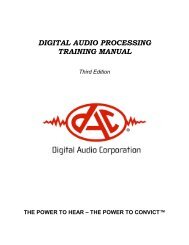QuickEnhance® VST User's Manual - Digital Audio Corporation
QuickEnhance® VST User's Manual - Digital Audio Corporation
QuickEnhance® VST User's Manual - Digital Audio Corporation
You also want an ePaper? Increase the reach of your titles
YUMPU automatically turns print PDFs into web optimized ePapers that Google loves.
what random noise is like. Wind noise comes to mind. Also sounds<br />
such as a nylon jacket rubbing against a “concealed” microphone. Sound<br />
familiar? Many noises we encounter are classified as random. Timecorrelated<br />
noises, though, have a repeatable, predictable “pattern.”<br />
Examples are tones, power line hum, and fluorescent light buzz. These<br />
noises can be effectively reduced using deconvolver filtering, and often<br />
this processing alone is enough to make a recording intelligible, even in<br />
the presence of random noises that cannot be reduced by the process.<br />
5.2.2 Convolutional<br />
The second type of noise is convolutional. These noises are the result of<br />
room acoustics and only exist if there is a sound source. In a room with<br />
no noise source, there is no convolutional noise. If a person speaks or<br />
some additive noise source is present, depending on the room acoustics,<br />
there may be an echo or reverberation. This echo is a convolutional<br />
noise. Sometimes it is so strong that it interferes with hearing the<br />
desired audio signal. It is also a repeatable, predictable signal (described<br />
above) and thus a time-correlated noise. In “hard (reverberant) rooms,”<br />
for example (sheet rock walls and ceiling, tile floor, no soft furniture,<br />
nothing to absorb sound waves), a sensitive microphone will pick up<br />
echoes that our ears might ignore, making the recording much worse<br />
than expected. Jail cells and interview rooms are good examples of hard<br />
rooms, and are the source of many bad recordings encountered by law<br />
enforcement. But, remember echoes are time-correlated, and<br />
deconvolver filtering can reduce time-correlated noises. Again this<br />
processing is often sufficient to allow an otherwise unintelligible<br />
recording to be understood.<br />
5.2.3 Distortion<br />
The third type of noise is distortion. The equipment we use to make the<br />
recording introduces this noise. Inexpensive microphones, bad cabling,<br />
poor quality recorders, cheap tapes, weak batteries — all contribute to<br />
distortion. Distortion, though, cannot be reduced without physically<br />
altering the recorded sounds. This could raise questions of “doctoring” if<br />
we tried to use the altered recording in court. We are lucky, though,<br />
because distortion typically has only a minimal effect on voice<br />
intelligibility; the main impact is on voice quality. Since we cannot do<br />
much with it, we will not address distortion any further, except to say<br />
that we should pay attention to all of the components of our system.<br />
Remember the old cliché about the weakest link — it applies here, too.<br />
Now putting noise into our “sound” perspective, it, too, can be defined in<br />
terms of frequency or frequency range (bandwidth) and energy level. And<br />
we will discover that some are easily reduced while others are not<br />
affected by current audio clarification techniques.<br />
16
















